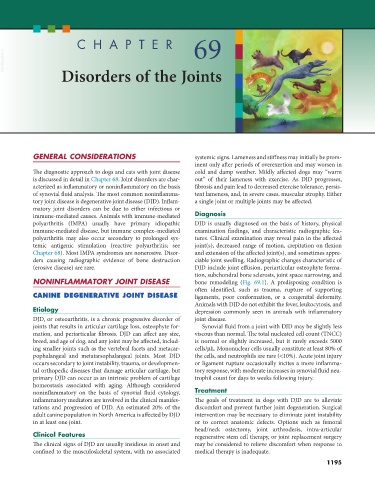Page 1223 - Small Animal Internal Medicine, 6th Edition
P. 1223
CHAPTER 69
VetBooks.ir
Disorders of the Joints
GENERAL CONSIDERATIONS systemic signs. Lameness and stiffness may initially be prom-
inent only after periods of overexertion and may worsen in
The diagnostic approach to dogs and cats with joint disease cold and damp weather. Mildly affected dogs may “warm
is discussed in detail in Chapter 68. Joint disorders are char- out” of their lameness with exercise. As DJD progresses,
acterized as inflammatory or noninflammatory on the basis fibrosis and pain lead to decreased exercise tolerance, persis-
of synovial fluid analysis. The most common noninflamma- tent lameness, and, in severe cases, muscular atrophy. Either
tory joint disease is degenerative joint disease (DJD). Inflam- a single joint or multiple joints may be affected.
matory joint disorders can be due to either infectious or
immune-mediated causes. Animals with immune-mediated Diagnosis
polyarthritis (IMPA) usually have primary idiopathic DJD is usually diagnosed on the basis of history, physical
immune-mediated disease, but immune complex–mediated examination findings, and characteristic radiographic fea-
polyarthritis may also occur secondary to prolonged sys- tures. Clinical examination may reveal pain in the affected
temic antigenic stimulation (reactive polyarthritis; see joint(s), decreased range of motion, crepitation on flexion
Chapter 68). Most IMPA syndromes are nonerosive. Disor- and extension of the affected joint(s), and sometimes appre-
ders causing radiographic evidence of bone destruction ciable joint swelling. Radiographic changes characteristic of
(erosive disease) are rare. DJD include joint effusion, periarticular osteophyte forma-
tion, subchondral bone sclerosis, joint space narrowing, and
NONINFLAMMATORY JOINT DISEASE bone remodeling (Fig. 69.1). A predisposing condition is
often identified, such as trauma, rupture of supporting
CANINE DEGENERATIVE JOINT DISEASE ligaments, poor conformation, or a congenital deformity.
Animals with DJD do not exhibit the fever, leukocytosis, and
Etiology depression commonly seen in animals with inflammatory
DJD, or osteoarthritis, is a chronic progressive disorder of joint disease.
joints that results in articular cartilage loss, osteophyte for- Synovial fluid from a joint with DJD may be slightly less
mation, and periarticular fibrosis. DJD can affect any size, viscous than normal. The total nucleated cell count (TNCC)
breed, and age of dog, and any joint may be affected, includ- is normal or slightly increased, but it rarely exceeds 5000
ing smaller joints such as the vertebral facets and metacar- cells/µL. Mononuclear cells usually constitute at least 80% of
pophalangeal and metatarsophalangeal joints. Most DJD the cells, and neutrophils are rare (<10%). Acute joint injury
occurs secondary to joint instability, trauma, or developmen- or ligament rupture occasionally incites a more inflamma-
tal orthopedic diseases that damage articular cartilage, but tory response, with moderate increases in synovial fluid neu-
primary DJD can occur as an intrinsic problem of cartilage trophil count for days to weeks following injury.
homeostasis associated with aging. Although considered
noninflammatory on the basis of synovial fluid cytology, Treatment
inflammatory mediators are involved in the clinical manifes- The goals of treatment in dogs with DJD are to alleviate
tations and progression of DJD. An estimated 20% of the discomfort and prevent further joint degeneration. Surgical
adult canine population in North America is affected by DJD intervention may be necessary to eliminate joint instability
in at least one joint. or to correct anatomic defects. Options such as femoral
head/neck ostectomy, joint arthrodesis, intra-articular
Clinical Features regenerative stem cell therapy, or joint replacement surgery
The clinical signs of DJD are usually insidious in onset and may be considered to relieve discomfort when response to
confined to the musculoskeletal system, with no associated medical therapy is inadequate.
1195

